In 2009, the gross domestic product (GDP) of the year was 33,535.3 billion yuan, up by 8.7 percent over the previous year. Analyzed by different industries, the value added of the primary industry was 3,547.7 billion yuan, up by 4.2 percent, that of the secondary industry was 15,695.8 billion yuan, up by 9.5 percent and the tertiary industry was 14,291.8 billion yuan, up by 8.9 percent. The value added of the primary industry accounted for 10.6 percent of the GDP, dropped by 0.1 percentage point over that in the pervious year, that of the secondary industry accounted for 46.8 percent, down by 0.7 percentage point, and that of the tertiary industry accounted for 42.6 percent, up by 0.8 percentage point.
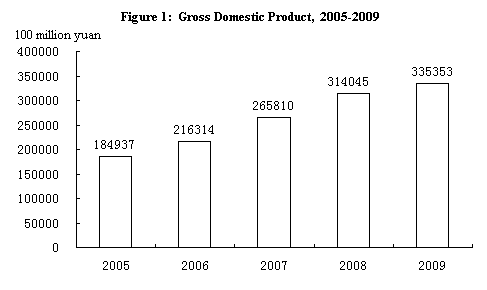
The general level of consumer prices in China was down by 0.7 percent over the previous year. Of this total, the prices for food went up by 0.7 percent. The prices for investment in fixed assets were down by 2.4 percent. The producer prices for manufactured goods dropped by 5.4 percent, of which, the prices for means of production down by 6.7 percent, and for means of subsistence decreased by 1.2 percent. The purchasing prices for raw materials, fuels and power went down by 7.9 percent. The producer prices for farm products were down by 2.4 percent. The prices for means of agricultural production were down by 2.5 percent. The sales prices for housing in 70 large and medium-sized cities were up by 1.5 percent, of which, that for new residential buildings went up by 1.3 percent, for second hand housing grew by 2.4 percent, and the prices for rental and leasing were down by 0.6 percent.
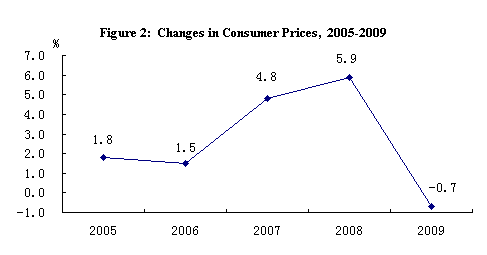
At the end of 2009, the total of employed people in China numbered 779.95 million, 5.15 million more than that of 2008. Of this total, 311.20 million were employed in urban areas, a net increase of 9.10 million, a newly increase of 11.02 million. The urban unemployment rate through unemployment registration was 4.3 percent at the end of 2009, an increase of 0.1 percentage point over that of 2008.
At the end of 2009, China’s foreign exchange reserves reached 2,399.2 billion US dollars, an increase of 453.1 billion US dollars as compared with that at the end of the pervious year. At the end of the year, the exchange rate was 6.8282 RMB to 1 USD, an appreciation by 0.1 percent over that at the end of 2008
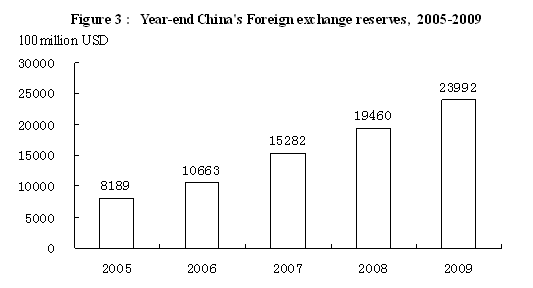
In 2009, the total fiscal revenue reached 6,847.7 billion yuan, up by 11.7 percent or an increase of 714.7 billion yuan over that in the previous year. Of this total, the taxes collected in the whole year reached 5,951.5 billion yuan, up by 9.8 percent or an increase of 529.1 billion yuan over 2008.
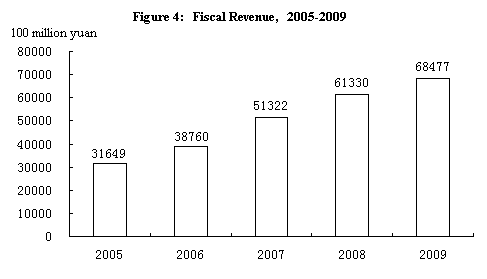
II. Agriculture
In 2009, the sown area of grain was 108.97 million hectares, an increase of 2.17 million hectares as compared with that in the previous year; the sown area of cotton was 4.95 million hectares, a decline of 800 thousand hectares; the sown area of oil-bearing crops was 13.60 million hectares, an increase of 760 thousand hectares; the sown area of sugar crops was 1.88 million hectares, a drop of 110 thousand hectares.
The total output of grain in 2009 was 530.82 million tons, an increase of 2.11 million tons or up by 0.4 percent over the previous year. Of this total, the output of summer crops was 123.35 million tons, up by 2.2 percent, and that of the early rice was 33.27 million tons, up by 5.3 percent over the previous year. The output of autumn grain was 374.20 million tons, a drop of 0.6 percent.
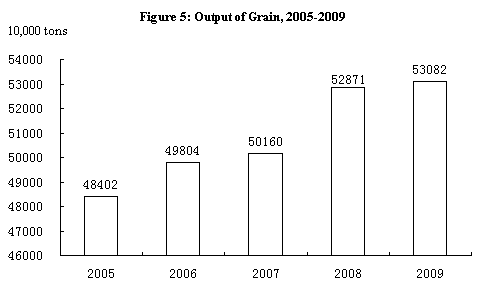
In 2009, the output of cotton was 6.40 million tons, a decrease of 14.6 percent over the previous year, that of oil-bearing crops was 31.00 million tons, up by 5.0 percent and that of sugar crops was 122.00 million tons, a drop of 9.1 percent, that of tobacco was 2.80 million tons, up by 6.7 percent, and that of tea was 1.35 million tons, up by 7.1 percent.
The total output of meat for the year reached 76.42 million tons, up by 5.0 percent. Of this total, the output of pork was 48.89 million tons, up by 5.8 percent, and that of beef and mutton was 6.36 and 3.89 million tons, up by 3.6 percent and 2.4 percent respectively. At the end of the year, 469.85 million pigs are registered in the total stocks, up by 1.5 percent, and 645.07 million pigs are slaughtered, up by 5.7 percent. The production of milk was 35.18 million tons, down by 1.1 percent; the total output of eggs was 27.41 million tons, up by 1.4 percent.
The total output of aquatic products was 51.20 million tons, up by 4.6 percent. Of this total, the output of cultured aquatic products was 36.35 million tons, up by 6.5 percent; and that of fished aquatic products was 14.85 million tons, up by 0.1 percent over the previous year.
The total production of timber for the year 2009 reached 69.38 million cubic meters, a drop of 14.4 percent.
Over 1.471 million hectares of farmland was increased with effective irrigation systems and another additional 1.826 million hectares of farmland was guaranteed by water-saving irrigation systems.
III. Industry and Construction
In 2009, the total value added of the industrial sector was 13,462.5 billion yuan, up by 8.3 percent over the previous year. The value added of industrial enterprises above the designated size was up by 11.0 percent. Of this total, that of the state-owned and state-holding enterprises grew by 6.9 percent, that of the collective enterprises went up by 10.2 percent, that of the share-holding enterprises increased by 13.3 percent, that of the enterprises by foreign investors and investors from Hong Kong, Macao and Taiwan soared by 6.2 percent and 18.7 percent growth for private enterprises. Analyzed by light and heavy industries, the growth of the light industry was 9.7 percent and that of the heavy industry was 11.5 percent.
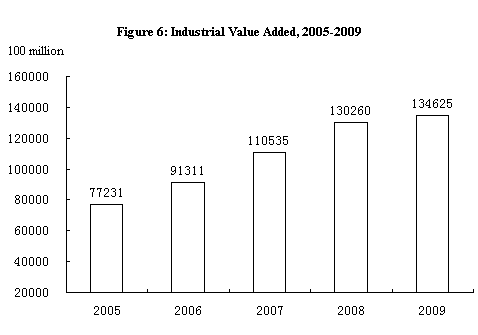
In 2009, of the industrial enterprises above designated size, the growth of value added for the mining and washing of coal industry was 8.3 percent over the previous year; for the extraction of petroleum and natural gas was 4.8 percent; for processing of food from agricultural product 15.9 percent; for textile industry 8.5 percent; for manufacture of general machinery 11.0 percent; for manufacture of special purpose machinery 13.0 percent; for manufacture of transport equipment 18.4 percent, of which, 20.3 percent for automobile manufacturing, and 20.7 percent for ship manufacturing; for manufacture of communication equipment, computers and other electronic equipment 5.3 percent and for manufacture of electrical machinery and equipment 12.0 percent. The growth of the value added for the major six high energy consuming industries were 10.6 percent, of which, that of the manufacture of non-metallic mineral products was 14.7 percent, manufacture of raw chemical materials and chemical products 14.6 percent, smelting and pressing of ferrous metals 12.8 percent, smelting and pressing of non-ferrous metals 9.9 percent, production and supply of electric power and heat power 6.0 percent and 5.2 percent for processing of petroleum, coking, processing of nuclear fuel. The value added growth for the high-tech industry was 7.7 percent over the previous year.
In 2009, the value added of construction enterprises in China was 2,233.3 billion yuan, up by 18.2 percent over the previous year. The profits made by construction enterprises qualified for general contracts and specialized contracts reached 266.3 billion yuan, up by 21.0 percent, of which the profits made by the state-owned and state-holding enterprises were 69.7 billion yuan, up by 23.9 percent.
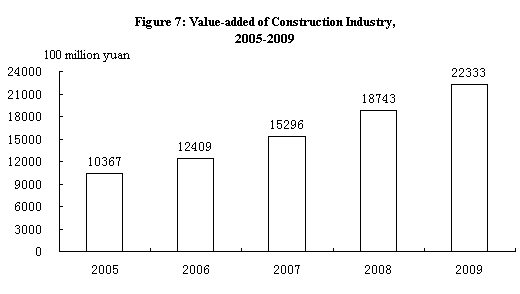
IV. Investment in Fixed Assets
The completed investment in fixed assets of the country in 2009 was 22,484.6 billion yuan, up by 30.1 percent over the previous year. Of the total investment, that in urban areas was 19,413.9 billon yuan, up by 30.5 percent; and that in rural areas reached 3,070.7 billion yuan, up by 27.5 percent. An analysis by regions showed that the investment in eastern areas was 9,565.3 billion yuan, up by 23.0 percent over the previous year, in central areas was 4,984.6 billion yuan, a growth of 35.8 percent, in western areas 4,966.2 billion yuan, a growth of 38.1 percent, and in northeastern areas 2,373.3 billion yuan, up by 26.8 percent.
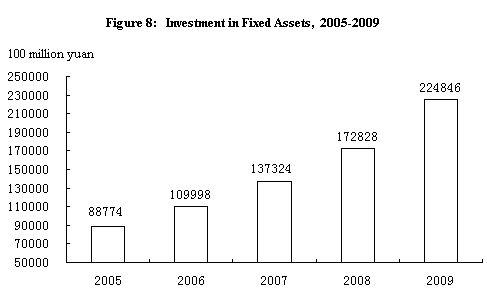
In the urban areas, the investment in the primary industry was 337.3 billion yuan, up by 49.9 percent; that in the secondary industry was 8,227.7 billion yuan, up by 26.8 percent; and that in the tertiary industry was 10,848.9 billion yuan, up by 33.0 percent.
In 2009, the investment in real estate development was 3,623.2 billion yuan, up by 16.1 percent. Of this total, the investment in commercial residential buildings reached 2,561.9 billion yuan, an increase of 14.2 percent, that in office buildings was 137.8 billion yuan, up by 18.1 percent, and that in buildings for commercial business was 417.2 billion yuan, up by 24.4 percent.
V. Domestic Trade
In 2009, the total retail sales of consumer goods reached 12,534.3 billion yuan, up by 15.5 percent over the previous year. An analysis on different areas showed that the retail sales of consumer goods in cities reached 8,513.3 billion yuan, up by 15.5 percent and the retail sales of consumer goods at and below county level was 4,021.0 billion yuan, up by 15.7 percent. Analyzed by different sectors, the sales of the wholesales and retail trade reached 10,541.3 billion yuan, up 15.6 percent; the sales of the lodging and catering industry was 1,799.8 billion yuan, up 16.8 percent, and the sales of the other industries was 193.2 billion yuan, up 2.5 percent.
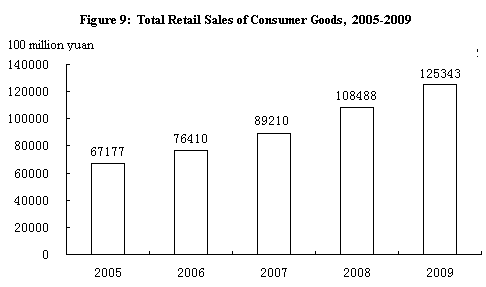
Of the total retail sales by wholesale and retail enterprises above designated size, the year-on-year growth of sales for motor vehicles was 32.3 percent, that for grain and oil was 13.0 percent, for meat and eggs 8.3 percent, for clothing 20.8 percent, for daily necessities 15.6 percent, for cultural and office goods 6.7 percent. The sales of telecommunication equipment dropped by 1.3 percent. The year-on-year growth of sales for cosmetics 16.9 percent, for gold, silver and jewelry 15.9 percent, for traditional Chinese drugs and western drugs 21.7 percent, for electric and electronic appliances for household use and audio-video equipment 12.3 percent, for furniture 35.5 percent and building and decoration materials 26.6 percent.
VI. Foreign Economic Relations
The total value of imports and exports in 2009 reached 2,207.2 billion US dollars, down by 13.9 percent over the previous year. Of this total, the value of goods export was 1,201.7 billion US dollars, down by 16.0 percent, and the value of goods import was 1,005.6 billion US dollars, down by 11.2 percent. The balance of imports and exports was (exports minus imports) 196.1 billion US dollars, a decrease of 102.0 billion US dollars over the previous year.
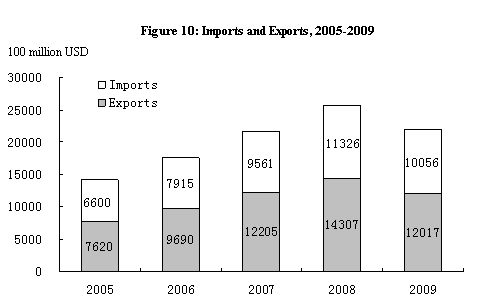
The year 2009 witnessed the establishment of 23,435 enterprises with foreign direct investment in non-financial sectors, down by 14.8 percent; and the foreign capital actually utilized was 90.0 billion US dollars, down by 2.6 percent. Of the total foreign direct investment actually utilized, the share of investment in manufacturing was 52.0 percent over the pervious year, the real estate 18.7 percent, leasing and business service 6.8 percent, wholesales and retail trade 6.0 percent and transportation, storage and post service 2.8 percent.
In 2009, the overseas direct investment (non-financial sectors) by Chinese investors was 43.3 billion US dollars, up by 6.5 percent over the previous year.
In 2009, the accomplished business revenue through contracted overseas engineering projects was 77.7 billion US dollars, up by 37.3 percent, and the business revenue through overseas labor contracts was 8.9 billion US dollars, up by 10.6 percent over the previous year.
VII. Transportation, Post, Telecommunications and Tourism
The value added of the transportation, storage, post and telecommunication sectors reached 1,705.8 billion yuan in 2009, up 3.7 percent over the previous year.
The volume of freight handled by ports above the designated size throughout the year totaled 6.91 billion tons, up 8.2 percent over the previous year, of which freight for foreign trade was 2.14 billion tons, up 8.6 percent. Container shipping handled 120.82 million standard containers, down by 5.8 percent.
The total number of motor vehicles for civilian use reached 76.19 million (including 13.31 million tri-wheel motor vehicles and low-speed trucks) by the end of 2009, up 17.8 percent, of which private-owned vehicles numbered 52.18 million, up 25.0 percent. The total number of cars for civilian use stood at 31.36 million, up by 28.6 percent, of which private-owned cars numbered 26.05 million, up by 33.8 percent.
The turnover of post and telecommunication services totaled 2,731.3 billion yuan, up 14.6 percent over the previous year. Of this total, post services accounted for 163.2 billion yuan, up 16.4 percent, and telecommunication services 2,568.1 billion yuan, up 14.4 percent. By the end of 2009, with a decrease of 16.44 million lines of office switchboards, the total capacity stood at 492.19 million lines. The newly increased capacity of mobile phone switchboard was 275.80 million lines with the total capacity reaching 1,421.11 million lines. The year also saw 313.69 million fixed telephone subscribers. This included 211.78 million urban subscribers and 101.91 million rural subscribers. Mobile phone users numbered 747.38 million by the end of 2009, with 106.14 million new subscribers in the year. In total, the number of fixed and mobile phone users reached 1,061.07 million, an increase of 79.47 million as compared with that at the end of 2008. Phone coverage is 79.9 sets per 100 persons. The number of Internet users was 380 million, of which wide-band users were 350 million, and the coverage rate of Internet was 28.9 percent.
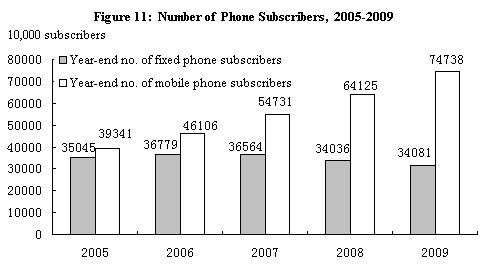
The year 2009 saw 1.90 billion domestic tourists, up 11.1 percent over the previous year. The revenue from domestic tourism totaled 1,018.4 billion yuan, up 16.4 percent. The number of inbound visitors to China totaled 126.48 million, a year-on-year decline of 2.7 percent. Of this total, 21.94 million were foreigners, down 9.8 percent; and 104.54 million were Chinese compatriots from Hong Kong, Macao and Taiwan, down 1.1 percent. Of all the inbound tourists, overnight visitors counted 50.88 million, down 4.1 percent. Foreign exchange earnings from international tourism topped 39.7 billion US dollars, down 2.9 percent. The number of China’s outbound visitors totaled 47.66 million, up 4.0 percent. Of this total, 42.21 million were on private visits, a year-on-year rise of 5.2 percent, or 88.6 percent of all outgoing visitors.
VIII. Financial Intermediation
By the end of 2009, money supply of broad sense (M2) was 60.6 trillion yuan, reflecting a year-on-year increase of 27.7 percent. Money supply of narrow sense (M1) was 22.0 trillion yuan, up 32.4 percent. Cash in circulation (M0) was 3.8 trillion yuan, up 11.8 percent.
Savings deposit in Renminbi and foreign currencies in all items of financial institutions totaled 61.2 trillion yuan at the end of 2009, an increase of 13.2 tirllion yuan. Of this total, the savings deposit in Renminbi stood at 59.8 trillion yuan, an increase of 13.1 trillionyuan. Loans in Renminbi and foreign currencies in all items of financial institutions reached 42.6 trillion yuan, an increase of 10.5 trillion yuan. Of this total, that in Renminbi was 40.0 trillion yuan, an increase of 9.6 trillion yuan.
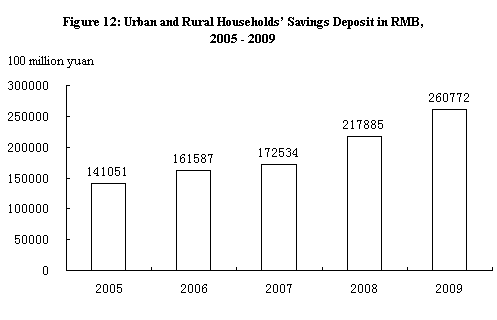
Loans in Renminbi from rural financial cooperation institutions (i.e. rural credit cooperatives, rural cooperation banks, and rural commercial banks) totaled 4.7 trillion yuan by the end of 2009, an increase of 972.7 billion yuan as compared with the beginning of 2009. The loans in Renminbi for consumption use from all financial institutions totaled 5.5 trillion yuan, an increase of 1,797.6 billion yuan. Of all consumption loans, short-term loans for individuals totaled 0.6 trillion yuan, an increase of 246.5 billion yuan, and medium- and long-term loans for individuals reached 4.9 trillion yuan, an increase of 1,551.1 billion yuan.
Funds raised in 2009 by enterprises through issuing stocks and share rights on stock market amounted to 365.3 billion yuan, an increase of 125.5 billion yuan over the previous year. Of this total, 99 A-shares were issued, receiving 206.2 billion yuan worth of capital altogether, an increase of 99.5 billion yuan. The refinancing of A-shares (including rationing shares, public newly issued, nonpublic newly issued and warrants) received 159.1 billion yuan worth of capital altogether, an increase of 25.9 billion yuan over 2008. The listed companies financed 81.3 billion yuan through convertible bonds, bonds with attached warrants and corporate bonds, a decrease of 18.5 billion yuan. A total of 36 growth enterprise board stocks were issued for the first time, receiving 20.4 billion yuan.
In 2009, corporate funds raised by the non-listed companies reached 425.2 billion yuan, an increase of 188.5 billion yuan over that in the previous year. The short-term financing funds of enterprises were 461.2 billion yuan, an increase of 28.1 billion yuan; and the medium-term notes were 698.7 billion yuan, an increase of 525.0 billion yuan. Funds raised by medium- and small-sized enterprises through collection notes reached 1.27 billion yuan.
The premium received by the insurance companies totaled 1,113.7 billion yuan in 2009, up 13.8 percent over the previous year. Of this total, life insurance premium amounted to 745.7 billion yuan, health and casualty insurance premium 80.4 billion yuan, and property insurance premium 287.6 billion yuan. Insurance companies paid an indemnity worth of 312.5 billion yuan, of which, life insurance indemnity was 126.9 billion yuan, health and casualty insurance indemnity 28.1 billion yuan, and property insurance indemnity 157.6 billion yuan.
IX. Education, Science and Technology
In 2009, the post-graduate education enrollment was 1.405 million students with 511 thousand new students and 371 thousand graduates. The general tertiary education enrollment was 21.447 million students with 6.395 million new students and 5.311 million graduates. Vocational secondary schools of various types had 21.787 million enrolled students, including 8.736 million new entrants, and 6.192 million graduates. Senior secondary schools had 24.343 million enrolled students, including 8.303 million new entrants, and 8.237 million graduates. Students enrolled in junior secondary schools totaled 54.409 million, including 17.885 million new entrants, and 17.977 million graduates. The country had a primary education enrollment of 100.715 million students, including 16.378 million new entrants, and 18.052 million graduates. There were 428 thousand students enrolled in special education schools, with 64 thousand new entrants. Kindergartens accommodated 26.578 million children.
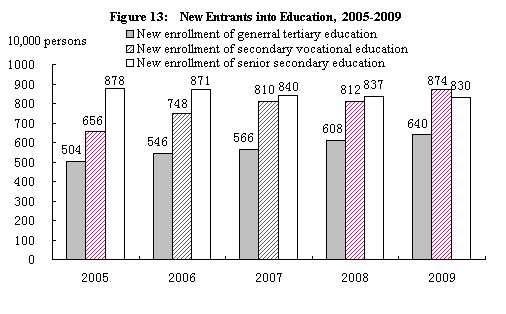
The amount of expenditures on research and development activities (R&D) was worth 543.3 billion yuan in 2009, up 17.7 percent over 2008, accounting for 1.62 percent of GDP. Of this total, 27.2 billion yuan was appropriated for fundamental research programs. A total number of 639 projects under the National Key Technology Research and Development Program and 1,328 projects under the Hi-tech Research and Development Program (the 863 Program) were implemented. The year 2009 saw a total of 127 national engineering research centers and 85 national engineering laboratories. The number of state validated enterprise technical centers reached 636 by the end of the year. The technical centers at the provincial level numbered 5,011. Venture capital investment plan had been initiated and implemented to boost new emerging industries, and 20 venture investment funds were established. Some 977 thousand patent applications were accepted from home and abroad, of which 878 thousand were domestic applications, accounting for 89.9 percent of the total. A total number of 315 thousand patent applications for new inventions were accepted, of which 229 thousand were from domestic applicants or 72.8 percent of the total. A total of 582 thousand patents were authorized in 2009, of which 502 thousand were domestic patents, accounting for 86.2 percent of the total. A total of 128 thousand patents for new inventions were authorized, of which 65 thousand were domestic ones, accounting for 50.9 percent. Till the end of year 2009, the number of patents in force was 1.520 million, of which 1.193 million patents were domestic ones, accounting for 78.5 percent; the number of patents in force for inventions was 438 thousand, of which 180 thousand was domestic ones, accounting for 41.1 percent. A total of 214 thousand technology transfer contracts were signed, representing 303.9 billion yuan in value, up 14.0 percent over the previous year. The year 2009 saw 6 times of successful launch of satellites. The first petaflop super computer Galaxy 1 was developed successfully, and ChangEr 1 satellite hit moon successfully.
By the end of 2009, there were altogether 25,000 laboratories for product inspection, including 414 national inspection centers. There were 168 organizations for product certification and management system certification, which accumulatively certified products in 41 thousand enterprises. A total of 3,760 authorized measurement institutions enforced compulsory inspection on 45.60 million measurement instruments in the year. A total of 3,158 national standards were developed or revised in the year, including 2,102 new standards. There were 2,737 weather warning signals sent by national and provincial meteorological stations, and 3,950 weather alerts. There were 1,457 seismological monitor stations and 32 seismological remote monitor network stations. The numbers of oceanic observation stations were 66. Mapping departments published 2,060 maps and 307 mapping books.
X. Culture, Public Health and Sports
At the end of 2009, there were 2,478 art-performing groups, 3,214 culture centers, 2,833 public libraries, 1,996 museums, 251 radio broadcasting stations, 272 television stations, 2,087 radio broadcasting and television stations and 44 educational television stations throughout China. Subscribers to cable television programs numbered 173.98 million. Subscribers to digital cable television programs were 62.00 million. Radio broadcasting and television broadcasting coverage rates were 96.3 percent and 97.2 percent respectively. The country produced 456 feature movies and 102 science, educational, documentary, cartoon and special movies. A total of 43.7 billion copies of newspapers and 3.1 billion copies of magazines were issued, and 7.0 billion copies of books published. By the end of the year, there were 4,035 archives in China and 79.91 million documents were made accessible to the public.
By the end of 2009, there were 289 thousand health institutions in China, including 60 thousand general hospitals and health centers, 26 thousand community health service centers, 3,013 maternal and child health-care institutions, 1,315 specialized health institutions, 3,543 epidemic disease prevention centers (stations) and 2,706 health monitoring institutions and 193 thousand clinics. There were 5.22 million health workers in China, including 2.16 million practicing doctors and assistant practicing doctors and 1.74 million registered nurses. General hospitals and health centers in China possessed 3.96 million beds. The number of rural health care centers was 39 thousand, possessing 910 thousand beds and employing 898 thousand health care workers. In 2009, 3.776 million people were infected by A or B class infectious diseases, with 15,105 reported deaths. The incidence of infectious disease was 284.34 per 100 thousand, with the death rate standing at 1.14 per 100 thousand.
In 2009, Chinese athletes won 142 world championships on 30 sports events. Eleven athletes and 3 teams broke 22 world records on 22 occasions. On the eleventh National Sports Games 7 athletes broke 5 world records on 9 occasions, 12 athletes and 3 teams broke 16 Asia records on 21 occasions and 29 athletes and 5 teams broke 39 national records on 52 occasions.
XI. Population, Living Conditions and Social Security
At the end of 2009, the total number of Chinese population reached 1,334.74 million, an increase of 6.72 million over that at the end of 2008. The year 2009 saw 16.15 million births, a crude birth rate of 12.13 per thousand, and 9.43 million deaths, or a crude death rate of 7.08 per thousand. The natural growth rate was 5.05 per thousand. The sex ratio at birth was 119.45.
In 2009, the annual per capita net income of rural households was 5,153 yuan, or a real increase of 8.5 percent over the previous year when the factors of price increase were deducted. The annual per capita disposable income of urban households was 17,175 yuan, or a real increase of 9.8 percent. The proportion of expenditure on food to the total expenditure of households was 41.0 percent for rural households and 36.5 percent for urban households. According to the 2009 rural poverty line with annual per capita net income below 1,196 yuan, the population in poverty in rural areas numbered 35.97 million at the end of the year.
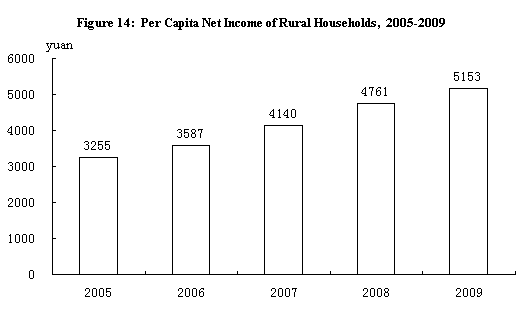
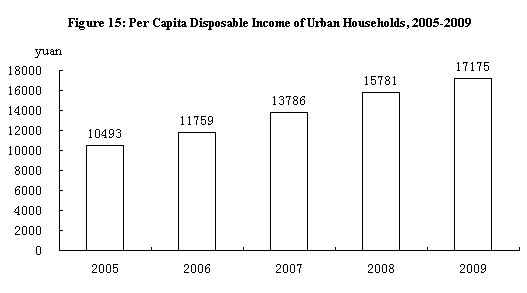
At the end of 2009, a total of 234.98 million people participated in basic pension program, a year-on-year increase of 16.07 million. Of this total, 177.03 million were staff and workers, and 57.95 million were retirees. A total of 400.61 million people participated in urban basic health insurance program, an increase of 82.39 million, of whom 219.61 million people participated in urban basic health insurance program for staff and workers, 181.00 million people participated in programs for residents. A total of 43.35 million people participated in urban health insurance programs were migrant workers coming from the rural areas, an increase of 690 thousand. Some 127.15 million people participated in unemployment insurance programs, an increase of 3.16 million. A total of 148.61 million people participated in work accident insurance, an increase of 10.74 million, of which 55.80 million were migrant workers coming from the rural areas, an increase of 6.38 million. A total of 108.60 million people participated in maternity insurance programs, an increase of 16.06 million. A total of 2,716 counties (cities, districts) conducted the new cooperative medical care system in rural areas, with a participation rate of 94.0 percent. The total expenditure of the new cooperative medical care system in rural areas reached 64.6 billion yuan, benefiting 490 million people. The pilot of new rural social pension insurance started smoothly. The number of people receiving unemployment insurance payment stood at 2.35 million in 2009.
By the end of 2009, there were all together 39 thousand social welfare institutions of various types providing 2,754 thousand beds, accommodating 2,088 thousand inmates. Of this total, 30 thousand were rural elder-caring organizations providing 1,885 thousand beds, accommodating 1,511 thousand inmates. There were 140 thousand community service facilities without accommodations, of which there were 9,726 community service centers and 25 thousand community service stations. A total of 23.477 million urban residents received the government minimum living allowances, or 129 thousand more than the previous year. About 47.593 million rural residents received the government minimum living allowance, an increase of 4,538 thousand and 5,543 thousand rural residents received government five-guarantees relief, an increase of 57 thousand. Medial aid was provided to 4,172 thousand needy people in cities and 6,884 thousand needy people in rural areas. Another 10.478 million needy people in urban areas were financed to participate in urban medical insurance system, and 36.898 million needy people in rural areas were financed to participate in new type of rural cooperative medical care system. A total of 75.6 billion yuan worth of social welfare lottery tickets were sold and a total of 4.1 billion yuan were received from direct donations.
XII. Resources, Environment and Work Safety
In 2009, land reclamation and re-development programs added 269 thousand hectares of cultivated land.
In 2009, the total supply of state-owned land for construction use was 319 thousand hectares, a growth of 44.2 percent over the previous year. Of this total, that for mining storage 119 thousand hectares, up 44.1 percent, for real estate development, 103 thousand hectares, up 36.7 percent, for infrastructure facilities, 97 thousand hectares, up 53.0 percent. In 2009, of the total 105 key cities covered by monitoring program the composite prices for land went up by 5.0 percent over the previous year, of which, the prices for commercial used land went up by 5.6 percent, for residential land, up 7.9 percent and 1.6 percent growth for industrial used land.
The total stock of water resources in 2009 was 2,376.3 billion cubic meters, a year-on-year decrease of 13.4 percent, or 1,784.9 cubic meters in per capita terms, down by 13.8 percent. The annual average precipitation was 583.1 millimeters, down by 10.9 percent. Large reservoirs in China stored 180.5 billion cubic meters of water at the end of 2009, 15.6 billion cubic meters less than that at the end of 2008. Total water consumption went up by 0.4 percent to reach 593.3 billion cubic meters, of which water consumption for living purposes rose by 2.9 percent, for industrial use down by 0.6 percent, for agricultural use up by 0.6 percent, and for ecological water supplement down by 9.8 percent. Water consumption for every 10 thousand yuan worth of GDP produced was 209.3 cubic meters, a decline of 7.6 percent. Water consumption for every 10 thousand yuan worth of industrial value added was 116.4 cubic meters, down by 8.2 percent. Per capita water consumption was 445.7 cubic meters, down by 0.1 percent.
National land surveys and geological explorations discovered a total of 398 new mineral deposits in large or medium size, including 107 energy mineral deposits, 177 metallic mineral deposits, 109 non-metallic mineral deposits and 5 aqueous and gaseous deposits. Increased reserves were found for 65 minerals, including 1.12 billion tons of crude oil, 723.4 billion cubic meters of natural gas and 50.36 billion tons of coal.
According to the results from the seventh National Forest Inventory, by the end of 2008, the total forest areas of China were 195.45 million hectares, and the forest coverage was 20.36 percent. The total stumpage volume reached 14.913 billion cubic meters and 13.721 billion cubic meters of forest volume.
In 2009, a total of 5.88 million hectares of forest were planted, of which 3.89 million were afforested by manpower. Some 4.47 million hectares were afforested through key afforestation projects, accounting for 76.0 percent of the total planted area of the year. About 2.48 billion trees were planted in 2009 by volunteers. By the end of 2009, there were 2,529 natural reserves including 319 national ones. A total of 48 thousand square kilometers of eroded land were put under comprehensive treatment programs, and 27 thousand square kilometers of land were closed for nurture and protection in areas suffering water and soil erosion. By the end of 2009, the total forest areas with set ownership were 100.93 million hectares, of this total, 75.73 million hectares obtained the forest ownership certifications.
The average temperature in 2009 was 9.8℃, Typhoon hit China 9 times in 2009.
Preliminary estimation indicated that the total energy consumption in 2009 amounted to 3.10 billion tons of standard coal equivalent, up 6.3 percent over 2008. The consumption of coal was 3.02 billion tons, up 9.2 percent; crude oil 380 million tons, up 7.1 percent; natural gas 88.7 billion cubic meters, up 9.1 percent; and electric power 3,697.3 billion kilowatt hours, up 6.2 percent. The national energy consumption per 10,000 yuan went down by 2.2 percent. The consumption of major kinds of raw materials included 690 million tons of rolled steel, up 22.4 percent; 7.53 million tons of copper, up by 39.7 percent; 14.39 million tons of electrolytic aluminum, up by 14.4 percent; 10.66 million tons of ethylene, up by 8.0 percent; and 1.63 billion tons of cement, up 17.0 percent.
Monitoring of water quality on 408 sections of the 7 major water systems in China showed that 57.1 percent of the sections met the national quality standard from Grade I to Grade III for surface water, up by 2.1 percentage points over the previous year; and 18.4 percent were worse than Grade V, down by 2.4 percentage points compared with that in the previous year. Generally, the water quality in the 7 major water systems continued to improve with some river basins still having serious pollution.
Monitoring of oceanic water quality at 299 offshore monitoring stations indicated that oceanic water met the national quality standard Grade I and II in 72.9 percent of the stations, up by 2.5 percentage points from the previous year; water quality at 6.0 percent of the stations met Grade III standard, down by 5.3 percentage points; and water of Grade IV or inferior quality was found at 21.1 percent of the stations, up by 2.8 percentage points.
In the 612 cities covered by air quality monitoring program, 504 cities reached or topped air quality standard Grade II, accounting for 82.4 percent of all cities under the program; 100 cities attained Grade III, accounting for 16.3 percent; and air quality in 8 cities was inferior to Grade III, accounting for 1.3 percent. Of the 327 cities subject to noise monitoring program, 4.9 percent enjoyed fairly good environment, 70.0 percent had good environment, 23.9 percent had light noise pollution, and 1.2 percent experienced medium noise pollution in downtown areas.
At the end of 2009, the daily treatment capacity of city sewage reached 86.64 million cubic meters, up 6.9 percent over that in 2008. City sewage treatment rate was 72.3 percent, up 2.1 percentage points. The floor space with central heating systems amounted to 3.56 billion square meters, up 2.0 percent. Greenery coverage reached 34.4 percent of the urban area, up 1.1 percentage point.
In 2009, natural disasters caused 252.4 billion yuan worth of direct economic loss, 78.5 percent less than that in previous year. Natural disasters hit 47.21 million hectares of crops, up 18.1 percent, of which 4.92 million hectares of crops was demolished, up 22.0 percent. Floods and waterlog caused a direct economic loss of 65.5 billion yuan, up by 0.5 percent and left a death roll of 902, down by 10.8 percent. Drought caused a direct economic loss of 109.9 billion yuan, an increase of 2.58 folds. Disasters from low temperature, frost and snow made a total direct economic loss of 17.2 billion yuan with a death roll of 40. Oceanic disasters caused a direct economic loss of 10.0 billion yuan, down by 51.3 percent. The occurrence of red tides hit an accumulative area of 14,102 square kilometers, up by 2.7 percent. China registered 10 thousand geological disasters, which left a death doll of 331 and made a total direct economic loss of 1.83 billion yuan. The country recorded 24 earthquakes with magnitude 5 and over, 8 of which caused disasters, causing a direct economic loss of 2.74 billion yuan and leaving a death roll of 3. The year 2009 witnessed 8,808 forest fires, down by 37.7 percent.
The death toll due to work accidents amounted to 83,196 people, a year-on-year decrease of 8.8 percent. The death toll from work accidents every 100 million yuan worth of GDP was 0.248 people, a decline of 20.5 percent. Work accidents in industrial, mining and commercial enterprises caused 2.4 deaths out of every 100 thousand employees, down 14.9 percent. The death toll for producing one million tons of coal in coalmines was 0.892 persons, down 24.5 percent. The year 2009 witnessed 238 thousand traffic accidents, claiming 68 thousand lives, injuring 275 thousand people and causing a direct property loss of 910 million yuan. The road traffic death toll per 10 thousand vehicles was 3.6 persons, a decrease of 0.7 person.





